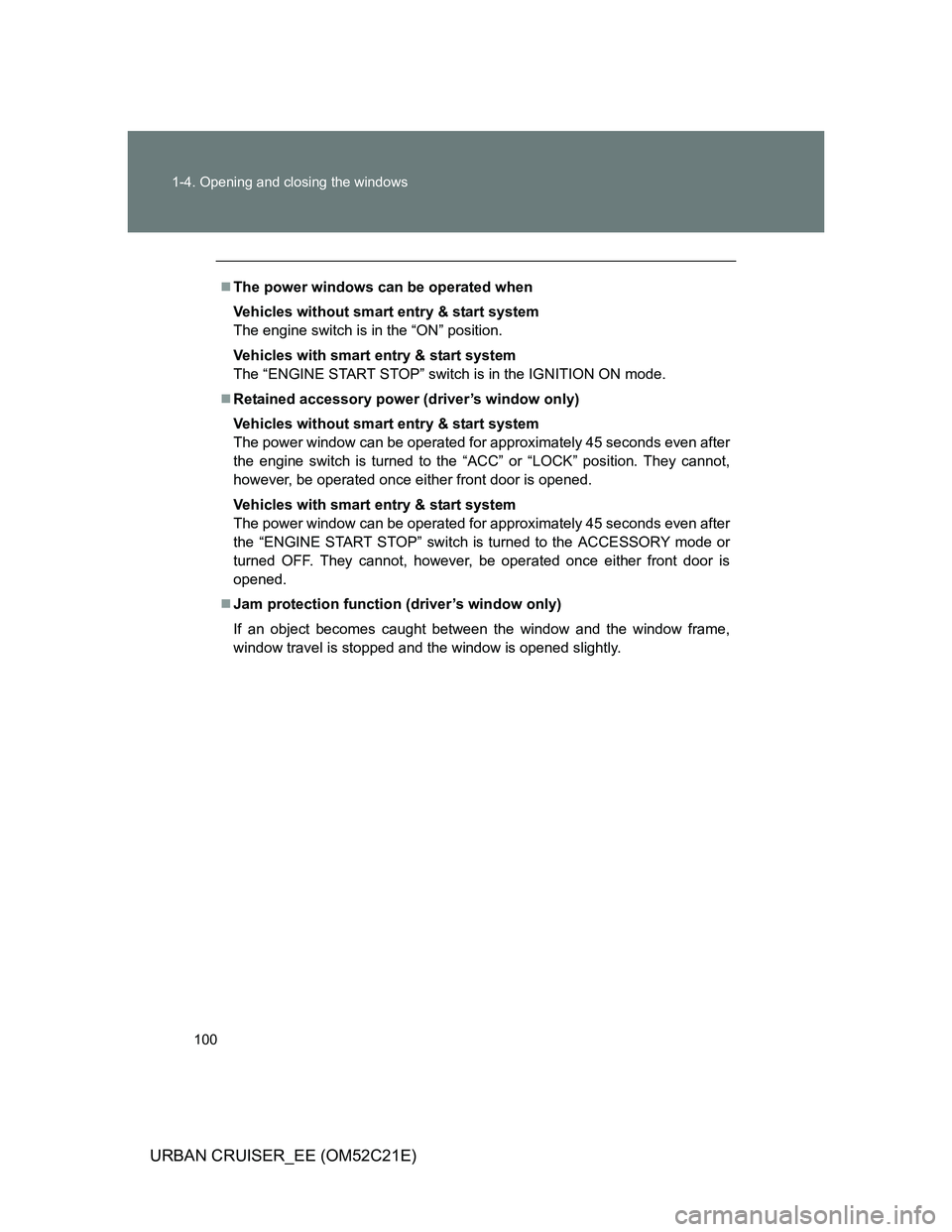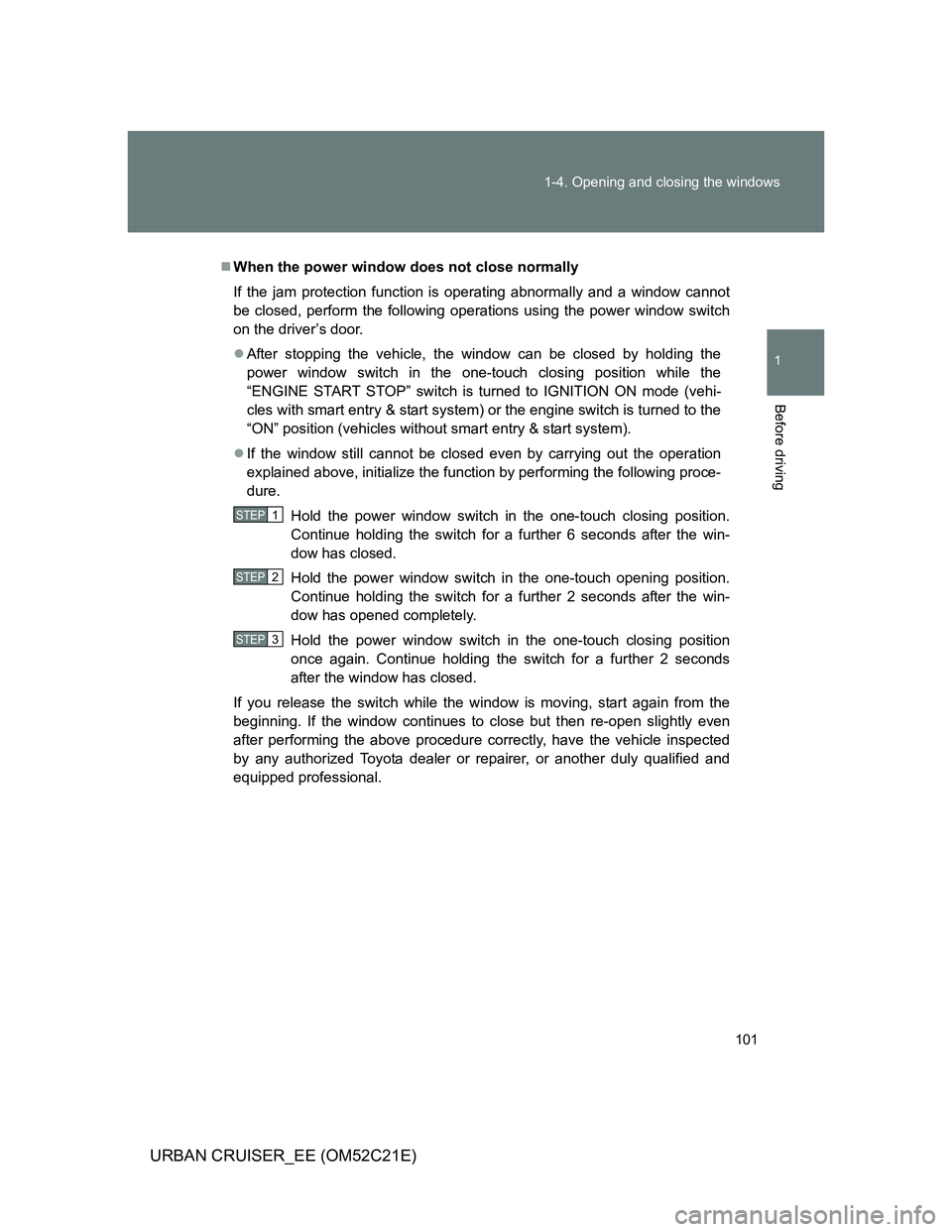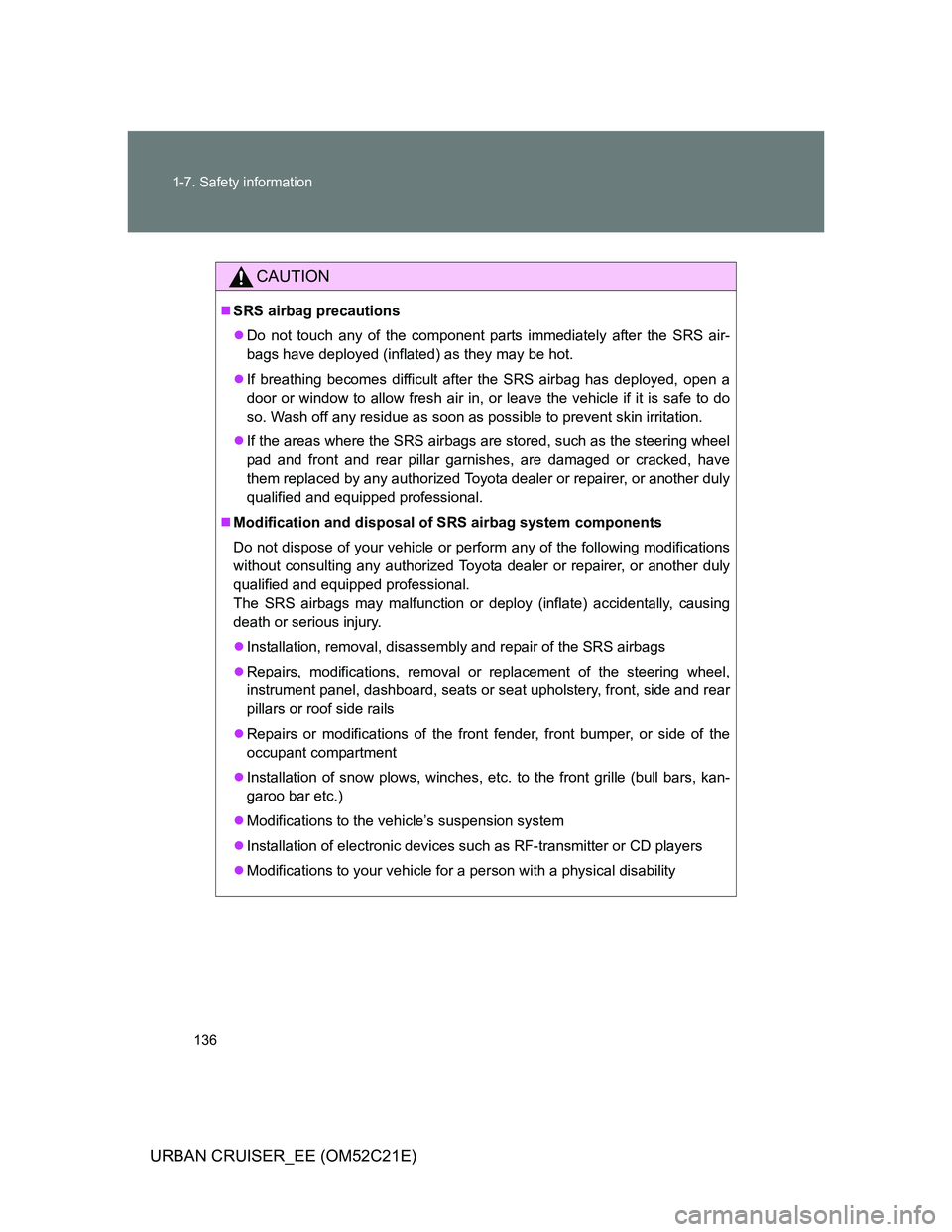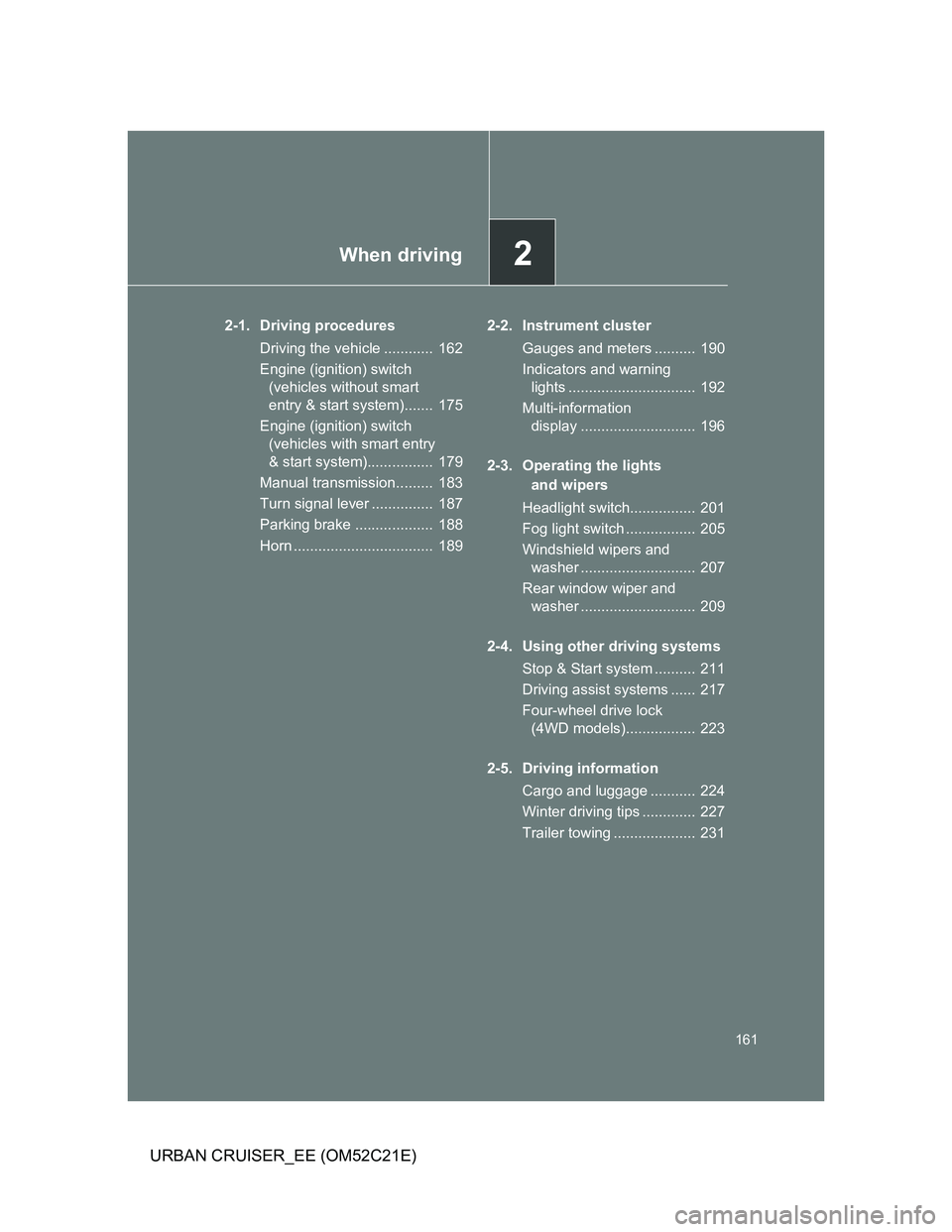Page 100 of 532

100 1-4. Opening and closing the windows
URBAN CRUISER_EE (OM52C21E)
The power windows can be operated when
Vehicles without smart entry & start system
The engine switch is in the “ON” position.
Vehicles with smart entry & start system
The “ENGINE START STOP” switch is in the IGNITION ON mode.
Retained accessory power (driver’s window only)
Vehicles without smart entry & start system
The power window can be operated for approximately 45 seconds even after
the engine switch is turned to the “ACC” or “LOCK” position. They cannot,
however, be operated once either front door is opened.
Vehicles with smart entry & start system
The power window can be operated for approximately 45 seconds even after
the “ENGINE START STOP” switch is turned to the ACCESSORY mode or
turned OFF. They cannot, however, be operated once either front door is
opened.
Jam protection function (driver’s window only)
If an object becomes caught between the window and the window frame,
window travel is stopped and the window is opened slightly.
Page 101 of 532

101 1-4. Opening and closing the windows
1
Before driving
URBAN CRUISER_EE (OM52C21E)
When the power window does not close normally
If the jam protection function is operating abnormally and a window cannot
be closed, perform the following operations using the power window switch
on the driver’s door.
After stopping the vehicle, the window can be closed by holding the
power window switch in the one-touch closing position while the
“ENGINE START STOP” switch is turned to IGNITION ON mode (vehi-
cles with smart entry & start system) or the engine switch is turned to the
“ON” position (vehicles without smart entry & start system).
If the window still cannot be closed even by carrying out the operation
explained above, initialize the function by performing the following proce-
dure.
Hold the power window switch in the one-touch closing position.
Continue holding the switch for a further 6 seconds after the win-
dow has closed.
Hold the power window switch in the one-touch opening position.
Continue holding the switch for a further 2 seconds after the win-
dow has opened completely.
Hold the power window switch in the one-touch closing position
once again. Continue holding the switch for a further 2 seconds
after the window has closed.
If you release the switch while the window is moving, start again from the
beginning. If the window continues to close but then re-open slightly even
after performing the above procedure correctly, have the vehicle inspected
by any authorized Toyota dealer or repairer, or another duly qualified and
equipped professional.
STEP1
STEP2
STEP3
Page 102 of 532
102 1-4. Opening and closing the windows
URBAN CRUISER_EE (OM52C21E)
CAUTION
Closing the windows
Observe the following precautions.
Failure to do so may result in death or serious injury.
Check to make sure that all passengers do not have any part of their body
in a position where it could be caught when a window is being operated.
Do not allow children to operate the power windows.
Closing a power window on someone can cause serious injury, and in
some instances, even death.
Jam protection function (driver’s window only)
Never try jamming any part of your body to activate the jam protection
function intentionally.
The jam protection function may not work if something gets caught just
before the window fully closes.
Page 103 of 532
103
1
Before driving
URBAN CRUISER_EE (OM52C21E)
1-5. Refueling
Opening the fuel tank cap
Perform the following steps to open the fuel tank cap.
Before refueling the vehicle
Vehicles without smart entry & start system
Turn the engine switch to the “LOCK” position and ensure that
all the doors and windows are closed.
Vehicles with smart entry & start system
Turn the “ENGINE START STOP” switch OFF and ensure that
all the doors and windows are closed.
Opening the fuel tank cap
Open the fuel filler door.
Turn the fuel tank cap slowly
to open.
STEP1
STEP2
Page 119 of 532
119 1-6. Theft deterrent system
1
Before driving
URBAN CRUISER_EE (OM52C21E)
System maintenance
The vehicle has a maintenance-free type alarm system.
Items to check before locking the vehicle
To prevent unexpected triggering of the alarm and vehicle theft, make sure
of the following.
Nobody is in the vehicle.
The windows are closed before the alarm is set.
No valuables or other personal items are left in the vehicle.
Deactivating or stopping the alarm
Do one of the following to deactivate or stop the alarm.
Unlock the doors using the smart entry & start system or the
wireless remote control.
Start the engine. (The alarm will be deactivated or stopped
after a few seconds.)
Page 136 of 532

136 1-7. Safety information
URBAN CRUISER_EE (OM52C21E)
CAUTION
SRS airbag precautions
Do not touch any of the component parts immediately after the SRS air-
bags have deployed (inflated) as they may be hot.
If breathing becomes difficult after the SRS airbag has deployed, open a
door or window to allow fresh air in, or leave the vehicle if it is safe to do
so. Wash off any residue as soon as possible to prevent skin irritation.
If the areas where the SRS airbags are stored, such as the steering wheel
pad and front and rear pillar garnishes, are damaged or cracked, have
them replaced by any authorized Toyota dealer or repairer, or another duly
qualified and equipped professional.
Modification and disposal of SRS airbag system components
Do not dispose of your vehicle or perform any of the following modifications
without consulting any authorized Toyota dealer or repairer, or another duly
qualified and equipped professional.
The SRS airbags may malfunction or deploy (inflate) accidentally, causing
death or serious injury.
Installation, removal, disassembly and repair of the SRS airbags
Repairs, modifications, removal or replacement of the steering wheel,
instrument panel, dashboard, seats or seat upholstery, front, side and rear
pillars or roof side rails
Repairs or modifications of the front fender, front bumper, or side of the
occupant compartment
Installation of snow plows, winches, etc. to the front grille (bull bars, kan-
garoo bar etc.)
Modifications to the vehicle’s suspension system
Installation of electronic devices such as RF-transmitter or CD players
Modifications to your vehicle for a person with a physical disability
Page 161 of 532

2When driving
161
URBAN CRUISER_EE (OM52C21E)
2-1. Driving procedures
Driving the vehicle ............ 162
Engine (ignition) switch
(vehicles without smart
entry & start system)....... 175
Engine (ignition) switch
(vehicles with smart entry
& start system)................ 179
Manual transmission......... 183
Turn signal lever ............... 187
Parking brake ................... 188
Horn .................................. 1892-2. Instrument cluster
Gauges and meters .......... 190
Indicators and warning
lights ............................... 192
Multi-information
display ............................ 196
2-3. Operating the lights
and wipers
Headlight switch................ 201
Fog light switch ................. 205
Windshield wipers and
washer ............................ 207
Rear window wiper and
washer ............................ 209
2-4. Using other driving systems
Stop & Start system .......... 211
Driving assist systems ...... 217
Four-wheel drive lock
(4WD models)................. 223
2-5. Driving information
Cargo and luggage ........... 224
Winter driving tips ............. 227
Trailer towing .................... 231
Page 164 of 532
164 2-1. Driving procedures
URBAN CRUISER_EE (OM52C21E)
Driving in the rain
Drive carefully when it is raining, because visibility will be reduced, the
windows may become fogged-up, and the road will be slippery.
Drive carefully when it starts to rain, because the road surface will be
especially slippery.
Refrain from high speeds when driving on an expressway in the rain,
because there may be a layer of water between the tires and the road
surface, preventing the steering and brakes from operating properly.
Breaking in your new Toyota
To extend the life of the vehicle, the following precautions are recommended
to observe:
For the first 300 km (200 miles):
Avoid sudden stops.
For the first 800 km (500 miles):
Do not tow a trailer.
For the first 1000 km (600 miles):
• Do not drive at extremely high speeds.
• Avoid sudden acceleration.
• Do not drive continuously in the low gears.
• Do not drive at a constant speed for extended periods.